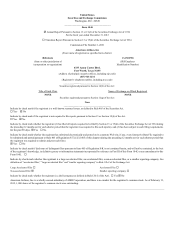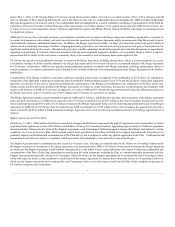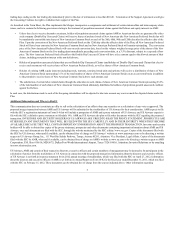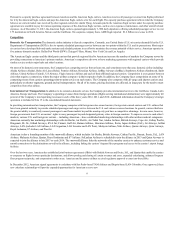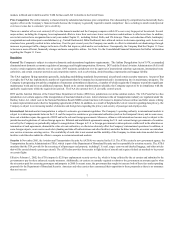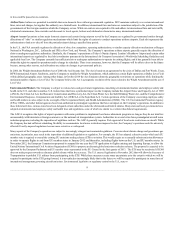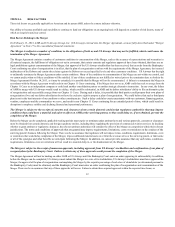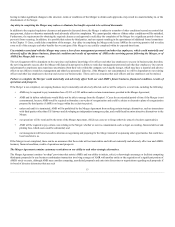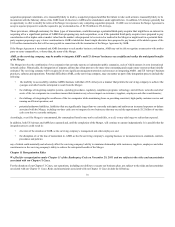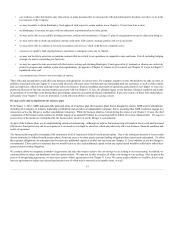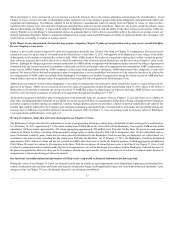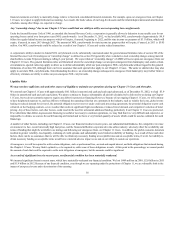American Airlines 2012 Annual Report Download - page 9
Download and view the complete annual report
Please find page 9 of the 2012 American Airlines annual report below. You can navigate through the pages in the report by either clicking on the pages listed below, or by using the keyword search tool below to find specific information within the annual report.
foreign governments currently or in the future may adversely affect the Company's business and financial results. See Item 1A, Risk Factors, for additional
information.
The environmental laws to which the Company is subject include those related to responsibility for potential soil and groundwater contamination. The
Company is conducting investigation and remediation activities to address soil and groundwater conditions at several sites, including airports and
maintenance bases. The Company anticipates that the ongoing costs of such activities will be immaterial. The Company has also been named as a potentially
responsible party (PRP) at certain Superfund sites. The Company’s alleged volumetric contributions at such sites are small in comparison to total
contributions of all PRPs and the Company expects that any future payments of its share of costs at such sites will be immaterial.
Labor
The airline business is labor intensive. Wages, salaries and benefits represented approximately 25 percent of the Company’s consolidated operating expenses
for the year ended December 31, 2012. The average full-time equivalent number of people employed by the Company for the year ended December 31, 2012
was 64,550.
The majority of the people employed by the Company are represented by labor unions and covered by CBAs. American's pilots are represented by the Allied
Pilots Association (APA), its flight attendants by the Association of Professional Flight Attendants (APFA), and its mechanics and fleet service employees, and
certain other employee groups, by the Transport Workers Union of America, AFL-CIO (TWU). AMR Eagle's pilots are represented by the Air Line Pilots
Association (ALPA), its flight attendants by the Association of Flight Attendants-CWA, AFL-CIO (AFA), and its mechanics and fleet service employees, and
certain other employee groups, by the TWU.
Relations with such labor organizations are governed by the Railway Labor Act (RLA). Under this act, the CBAs between the Company’s subsidiaries and
these organizations generally do not expire but instead become amendable as of a stated date. If either party wishes to modify the terms of any such agreement,
it must notify the other party in the manner prescribed under the RLA and as agreed to by the parties. Under the RLA, after receipt of such notice, the parties
must meet for direct negotiations, and if no agreement is reached, either party may request the NMB to appoint a federal mediator. The RLA prescribes no set
timetable for the direct negotiation and mediation process. It is not unusual for those processes to last for many months, and even for several years. If no
agreement is reached in mediation, the NMB in its discretion may declare at some time that an impasse exists, and if an impasse is declared, the NMB
proffers binding arbitration to the parties. Either party may decline to submit to arbitration. If arbitration is rejected by either party, a 30-day “cooling off”
period commences. During that period (or after), a Presidential Emergency Board (PEB) may be established, which examines the parties’ positions and
recommends a solution. The PEB process lasts for 30 days and is followed by another “cooling off” period of 30 days. At the end of a “cooling off” period,
unless an agreement is reached or action is taken by Congress, the labor organization may exercise “self-help,” such as a strike, and the airline may resort to
its own “self-help,” including the imposition of any or all of its proposed amendments and the hiring of new people to replace any striking workers.
Prior to the Chapter 11 filings on November 29, 2011, American had been in negotiations with its unions under the RLA for as long as five years. As of
December 31, 2012, American and AMR Eagle have new contracts with all of their respective labor groups. See Note 1 to the consolidated financial statements
and Item 7, "Management's Discussion and Analysis of Financial Condition and Results of Operations" for further information on the Company's CBAs.
Fuel
The Company’s operations and financial results are significantly affected by the availability and price of jet fuel. The Company’s fuel costs and consumption
for the years 2010 through 2012 were:
Year
Gallons
Consumed
(in millions)
Total Cost
(in millions)
Average Cost
Per Gallon
(in dollars)
Percent of
American’s
Operating
Expenses
2010
2,481
5,731
2.310
26.1
2011
2,445
7,434
3.009
29.6
2012
2,410
8,717
3.198
35.2
In order to provide a measure of control over price and supply, the Company trades and ships fuel and maintains fuel storage facilities to support its flight
operations. The Company also manages the price risk of fuel costs through the use of hedging contracts, which consist primarily of call options, collars
(consisting of a purchased call option and a sold put option) and call spreads (consisting of a purchased call option and a sold call option). Heating oil, jet fuel
and crude oil are the primary underlying commodities in the hedge portfolio. The Company does not take a view on the direction of fuel prices; instead, the
Company
9

